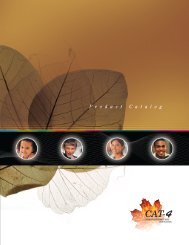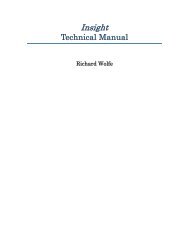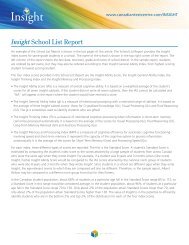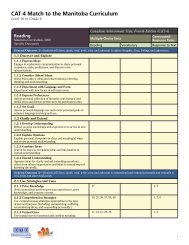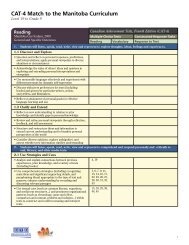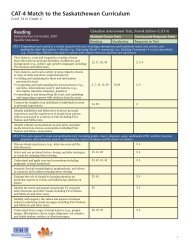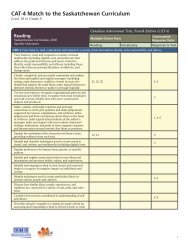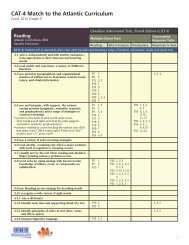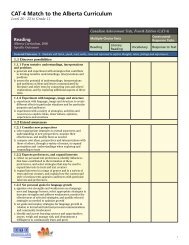Grade 10 - Canadian Test Centre
Grade 10 - Canadian Test Centre
Grade 10 - Canadian Test Centre
You also want an ePaper? Increase the reach of your titles
YUMPU automatically turns print PDFs into web optimized ePapers that Google loves.
CAT∙4 Match to the Alberta Curriculum<br />
Level 20 - 22 to <strong>Grade</strong> <strong>10</strong><br />
Reading<br />
Alberta Curriculum, 2000<br />
Specific Outcomes<br />
2.3 Respond to a variety of print and nonprint texts<br />
2.3.1 Connect self, text, culture and milieu<br />
a. identify and consider personal, moral, ethical and cultural<br />
perspectives when studying literature and other texts;<br />
and reflect on and monitor how perspectives change as a<br />
result of interpretation and discussion<br />
b. respond personally and analytically to ideas developed<br />
in works of literature and other texts; and analyze the<br />
ways in which ideas are reflected in personal and cultural<br />
opinions, values, beliefs and perspectives<br />
c. compare choices and motives of characters and people<br />
portrayed in texts with choices and motives of self and<br />
others<br />
d. identify and examine ways in which cultural and societal<br />
influences are reflected in a variety of <strong>Canadian</strong> and<br />
international texts<br />
2.3.2 Evaluate the verisimilitude, appropriateness and<br />
significance of print and nonprint texts<br />
a. identify criteria to evaluate the effectiveness of texts,<br />
monitor the effectiveness of the criteria, and modify the<br />
criteria as needed<br />
b. assess the appropriateness of own and others’<br />
understandings and interpretations of works of literature<br />
and other texts, by referring to the works and texts for<br />
supporting or contradictory evidence<br />
c. describe settings and plots in terms of reality and<br />
plausibility, as appropriate<br />
d. describe character and characterization in terms of<br />
consistency of behaviour, motivation and plausibility<br />
e. describe images in print and nonprint texts in terms of<br />
created reality and appropriateness to purpose<br />
f. assess the significance of a text’s theme or controlling<br />
idea, and the adequacy, relevance and effectiveness of its<br />
supporting details, examples or illustrations, and content<br />
in general<br />
2.3.3 Appreciate the effectiveness and artistry of print<br />
and nonprint texts<br />
a. use terminology appropriate to the forms studied for<br />
discussing and appreciating the effectiveness and artistry<br />
of a variety of text forms<br />
b. describe the effectiveness of various texts, including<br />
media texts, for presenting feelings, ideas and<br />
information, and for evoking response<br />
<strong>Canadian</strong> Achievement <strong>Test</strong>s, Fourth Edition (CAT·4)<br />
Multiple-Choice <strong>Test</strong>s<br />
Reading<br />
8, <strong>10</strong>, 17, 18,<br />
27, 30, 39<br />
14, 21, 23, 31,<br />
32, 37, 40<br />
Literary<br />
Reading<br />
3, 11, 16, 22,<br />
23, 24, 30, 38<br />
8, <strong>10</strong>, 17<br />
Vocabulary<br />
Constructed-<br />
Response Tasks<br />
Response to Text<br />
4



